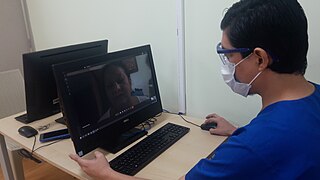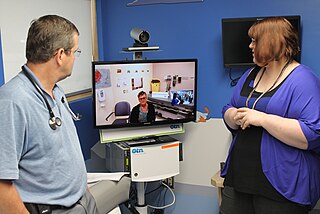
Health informatics is the study and implementation of computer structures and algorithms to improve communication, understanding, and management of medical information. It can be view as branch of engineering and applied science.

Telehealth is the distribution of health-related services and information via electronic information and telecommunication technologies. It allows long-distance patient and clinician contact, care, advice, reminders, education, intervention, monitoring, and remote admissions. Telemedicine is sometimes used as a synonym, or is used in a more limited sense to describe remote clinical services, such as diagnosis and monitoring. When rural settings, lack of transport, a lack of mobility, conditions due to outbreaks, epidemics or pandemics, decreased funding, or a lack of staff restrict access to care, telehealth may bridge the gap as well as provide distance-learning; meetings, supervision, and presentations between practitioners; online information and health data management and healthcare system integration. Telehealth could include two clinicians discussing a case over video conference; a robotic surgery occurring through remote access; physical therapy done via digital monitoring instruments, live feed and application combinations; tests being forwarded between facilities for interpretation by a higher specialist; home monitoring through continuous sending of patient health data; client to practitioner online conference; or even videophone interpretation during a consult.
eHealth describes healthcare services which are supported by digital processes, communication or technology such as electronic prescribing, Telehealth, or Electronic Health Records (EHRs). The use of electronic processes in healthcare dated back to at least the 1990s. Usage of the term varies as it covers not just "Internet medicine" as it was conceived during that time, but also "virtually everything related to computers and medicine". A study in 2005 found 51 unique definitions. Some argue that it is interchangeable with health informatics with a broad definition covering electronic/digital processes in health while others use it in the narrower sense of healthcare practice using the Internet. It can also include health applications and links on mobile phones, referred to as mHealth or m-Health.

Telenursing refers to the use of information technology in the provision of nursing services whenever physical distance exists between patient and nurse, or between any number of nurses. As a field, it is part of telemedicine, and has many points of contacts with other medical and non-medical applications, such as telediagnosis, teleconsultation, and telemonitoring. The field, however, is still being developed as the information on telenursing isn't comprehensive enough.

Medical education is education related to the practice of being a medical practitioner, including the initial training to become a physician and additional training thereafter.
Normalization refers to social processes through which ideas and actions come to be seen as 'normal' and become taken-for-granted or 'natural' in everyday life. There are different behavioral attitudes that humans accept as normal, such as grief for a loved one, avoiding danger, and not participating in cannibalism.

Victor Montori is a professor of medicine at the Mayo Clinic in Rochester, Minnesota, USA. He was born and raised in Lima, Peru. He completed medical school at Universidad Peruana Cayetano Heredia in Peru, before joining the Internal Medicine Residency Program at the Mayo Clinic. He was named Chief Resident of the Department of Internal Medicine from 1999 to 2000.

In medicine, rural health or rural medicine is the interdisciplinary study of health and health care delivery in rural environments. The concept of rural health incorporates many fields, including wilderness medicine, geography, midwifery, nursing, sociology, economics, and telehealth or telemedicine.
Home automation for the elderly and disabled focuses on making it possible for older adults and people with disabilities to remain at home, safe and comfortable. Home automation is becoming a viable option for older adults and people with disabilities who would prefer to stay in the comfort of their homes rather than move to a healthcare facility. This field uses much of the same technology and equipment as home automation for security, entertainment, and energy conservation but tailors it towards old people and people with disabilities.
The Normalization process model is a sociological model, developed by Carl R. May, that describes the adoption of new technologies in health care. The model provides framework for process evaluation using three components – actors, objects, and contexts – that are compared across four constructs: Interactional workability, relational integration, skill-set workability, and contextual integration. This model helped build the Normalization process theory.
Normalization process theory (NPT) is a sociological theory, generally used in the fields of science and technology studies (STS), Implementation Science, and healthcare system research. The theory deals with the adoption of technological and organizational innovations into systems, recent studies have utilized this theory in evaluating new practices in social care and education settings. It was developed out of the normalization process model.
Implementation research is the systematic study of methods that support the application of research findings and other evidence-based knowledge into policy and practice. It aims to understand the most effective pathways from research to practical application, particularly in areas such as health, education, psychology and management. Intervention research, also known as intervention science, evaluates how various interventions or approaches are adopted and applied in “real world” settings in order to establish an understanding of their effectiveness in different contexts.
Patient participation is a trend that arose in answer to medical paternalism. Informed consent is a process where patients make decisions informed by the advice of medical professionals.
Minimally disruptive medicine is an approach to patient care in chronic illness proposed by Carl R May, Victor Montori, and Frances Mair. In a 2009 article in the British Medical Journal they argued that the burden of illness has its counterpart in the burden of treatment. As medical responses to illness have become more sophisticated, the burden of treatment has grown, and includes increasingly complex techniques and health technologies that must be routinely incorporated in everyday life by their users. minimally disruptive medicine is an approach to designing patient care that seeks to consider the effects of treatment work, and in particular to prevent overburdening patients. Overburdening leads, May, Montori and Mair argued, to structurally induced non-compliance with treatment, in which it becomes progressively more difficult for patients – especially older patients with multiple long-term conditions – to meet the demands that therapeutic regimens place upon them. minimally disruptive medicine has a theoretical basis in Normalization Process Theory, which explains the processes by which treatment regimens and other ensembles of cognitive, behavioural and technical practices are routinely incorporated in everyday life.
Decision aids are interventions or tools designed to facilitate shared decision making and patient participation in health care decisions.
Digital health is a discipline that includes digital care programs, technologies with health, healthcare, living, and society to enhance the efficiency of healthcare delivery and to make medicine more personalized and precise. It uses information and communication technologies to facilitate understanding of health problems and challenges faced by people receiving medical treatment and social prescribing in more personalised and precise ways. The definitions of digital health and its remits overlap in many ways with those of health and medical informatics.
Model for assessment of telemedicine (MAST) is a framework for assessment of the value of telemedicine.

Medical sociology is the sociological analysis of medical organizations and institutions; the production of knowledge and selection of methods, the actions and interactions of healthcare professionals, and the social or cultural effects of medical practice. The field commonly interacts with the sociology of knowledge, science and technology studies, and social epistemology. Medical sociologists are also interested in the qualitative experiences of patients, often working at the boundaries of public health, social work, demography and gerontology to explore phenomena at the intersection of the social and clinical sciences. Health disparities commonly relate to typical categories such as class and race. Objective sociological research findings quickly become a normative and political issue.
Learning health systems (LHS) are health and healthcare systems in which knowledge generation processes are embedded in daily practice to improve individual and population health. At its most fundamental level, a learning health system applies a conceptual approach wherein science, informatics, incentives, and culture are aligned to support continuous improvement, innovation, and equity, and seamlessly embed knowledge and best practices into care delivery
The taxonomy of the burden of treatment is a visualization created for health care professionals to better comprehend the obstacles that interfere with a patient's health care plan. It was created as a result of a worldwide, qualitative-based study that asked adults with chronic conditions to list the personal, environmental, and financial barriers that burden a patient. The purpose of this visualization is to help health care providers develop personalized management strategies that the patient can follow through a narrative paradigm. The goal is to target interventions, achieve an interpersonal doctor-patient relationship, and improve health outcomes.






